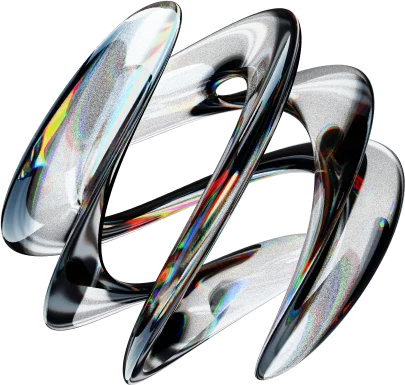Without boasting a cutting-edge tech stack in its arsenal, a design agency cannot create intuitive, user-friendly, and scalable design solutions.
When hiring a UI/UX design agency, not only should you look into their popularity and portfolio but also their tools and whether they keep themselves updated with the latest trends in the design industry.
Here we picked the best UI design tools based on the different stages of UI/UX design, including:
- User research
- Wireframing
- Prototyping & Interaction Design
- User Testing & Feedback
- Design collaboration & Developer Handoff
- Coding for UI Implementation
With this detailed guide, we believe you will be able to partner up with the best design agency suited to your unique business needs.
Best for User Research
One of the first things you should do before even starting out your design is proper research. This will help you plan your steps and find the right direction.
Here are some tools you can conduct research with.
Userlytics – Top Beginner’s Choice
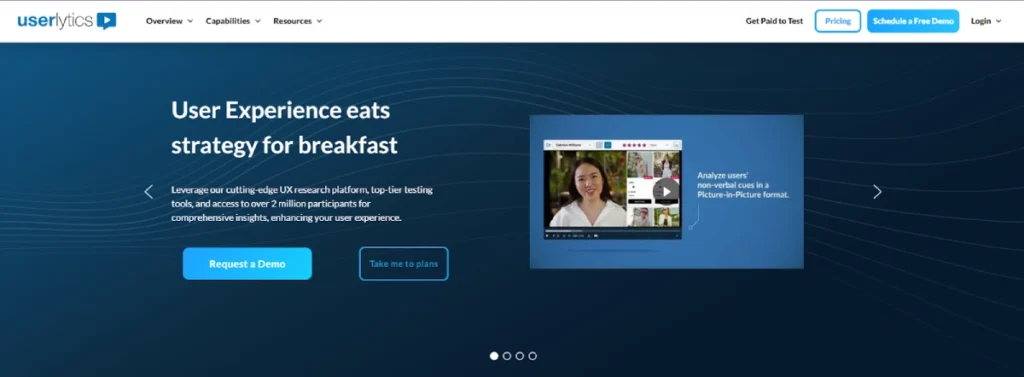
Main features: user experience studies, tree testing, usability tests, card sorting
Notable users: Logitech, Riot Games, Verizon, Nespresso, Canon
Website link: https://www.userlytics.com/
If you are looking for a great platform you can use to conduct research on any digital products such as websites, prototypes, mobile apps, and other similar things, Userlytics is the platform for you. You can set up any filters or metrics according to your needs and collect any datasets and graphical reports. Whether you are collecting quantitative or qualitative data, Userlytics is the platform for you.
The services start at $49 a month. You can conduct different combinations of tests such as usability tests, tree testing, user experience studies, and card sorting. You can even choose to moderate them or not based on users.
Optimal Workshop – For Most Refined Services
Main features: Card sorting, tree testing, first click testing, online surveys, qualitative research
Price: $208 per month
Notable users:
Website link: https://www.optimalworkshop.com/
Another platform with a very literal naming convention, Optimal Workshop provides tools to collect valuable data and insights for user research.
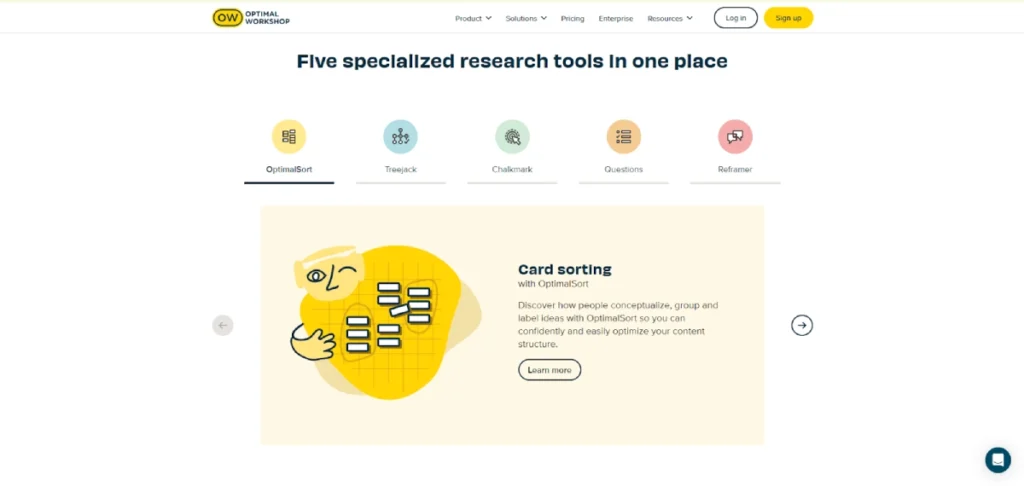
They offer 5 different specialized tools that do card sorting, tree testing, first click testing, online surveys, and qualitative research. They offer a free trial with a limited number of uses for each tool. Their paid plans start at $208 per month with unlimited access to their resources.
Maze – Best All – Around Research Tool
Main features: Integration with popular tools, Real-time reports, Remote testing, IA testing, Collaboration features, Templates, Question repositories
Price: $99 a month
Notable users: National Geographic Society, Walmart, Cisco, McKinsey & Company
Website link: https://maze.co/
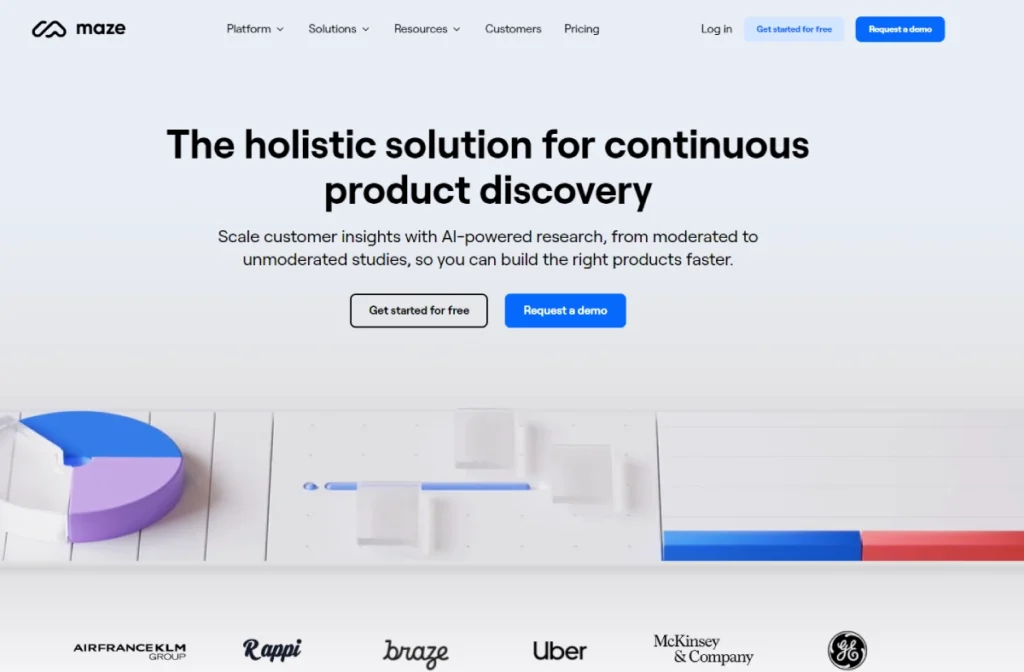
Maze is a product discovery platform that allows teams to collect user insights and datasets. You can run all kinds of research with the option to fix metrics to your needs. The great thing about Maze is that it seamlessly integrates with popular design tools like Figma, Sketch, and many more making the process of collecting data easier.
Maze is free for one project and five seats per month, after which you have to pay $99 a month to continue using their services. Their key features include integration with popular tools, real-time reports, remote testing, IA testing, collaboration features, templates, and question repositories.
User Interviews – Best for User Interviews
Main features: Recruitment, Integration with UI tools, Automated research, Interview scheduling, Survey, Moderated and unmoderated research
Price: $250 a month
Notable users: Adobe, Spotify, Pinterest, Amazon
Website link: https://www.userinterviews.com/
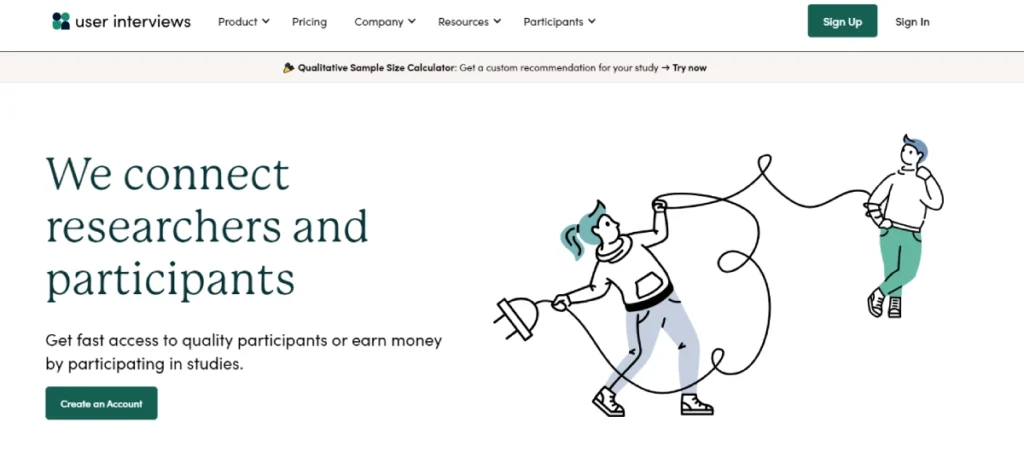
User Interviews is a well-reputed platform that as the name implies, specializes in user interviews. They have over 350,000 vetted research participants from whom you can sample and collect valuable insights based on your metrics.
Their prices start at $40 per session. You can also opt into their $ 250-a-month plan. User Interviews offers features like screener surveys, scheduling interviews, and participation tracking for your existing users. It usually takes around 2 hours to deliver a project after requesting but it can vary based on research subject matters and participants.
SurveyMonkey – Top Survey Tool
Main features: Online surveys, Integration with top-used tools
Price: $25 a month
Notable users: Uber, Addidas, Hershey’s, Kellogg’s, Sephora
Website link: https://www.surveymonkey.com/
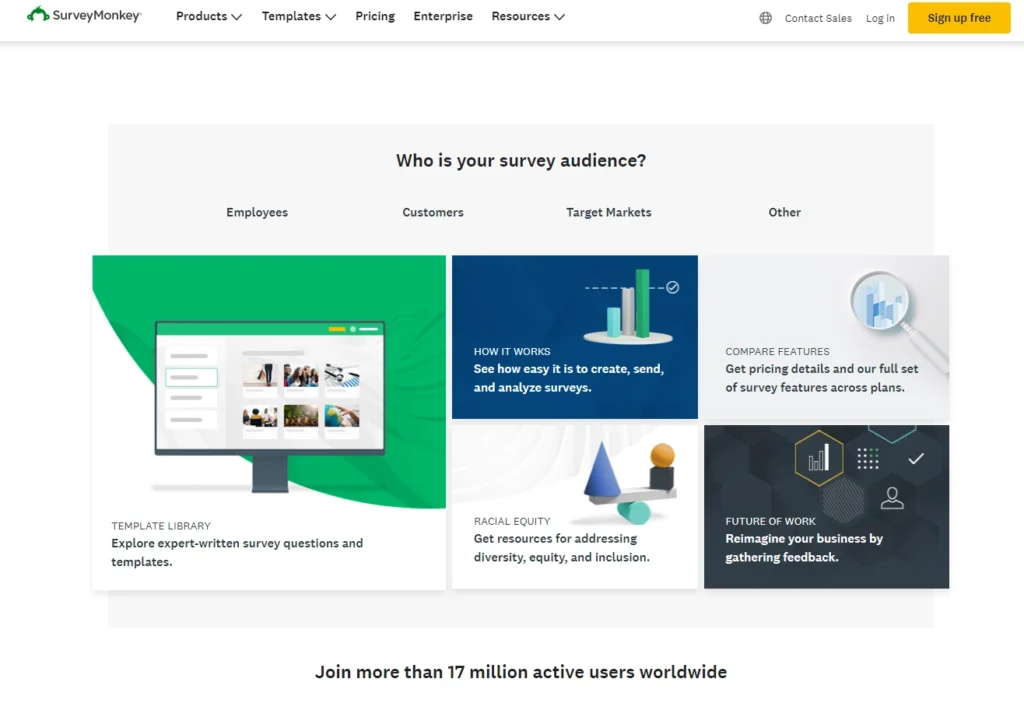
SurveyMonkey specializes in conducting surveys. They are probably the world’s most popular surveying tool. Along with that, they provide all sorts of resources to give you an idea of how to get the most results out of your surveys.
They allow unlimited surveys for free with the limitation that each survey cannot have more than 10 questions. Their premium services start at $34 a month for individual plans and $25 a month per person for team plans.
Best for Wireframing
Creating sketches and wireframes is one of the first steps in user interface (UI) design. Wireframes are created with basic lines and shapes to get an understanding of what kind of layout should be used. A mockup is created when design elements are put into it.
The most basic and easy way to create them is by using a pen and paper, but that’s not what you came to know from this site, is it? Here are some industry-standard design tools to get you started on your journey.
Figma – The Industry Standard
Main features: Design, Prototyping, Dev mode, Design systems, Team Collaboration
Price: $12 a month
Notable users: Microsoft, The New York Times, Airbnb, Coinbase
Website link: https://www.figma.com/
Advantage:
- All-rounder tool that can handle most tasks
- Great for beginners and pros alike
Disadvantage:
- Will need the help of other tools for more specialized actions
- Can get expensive over time
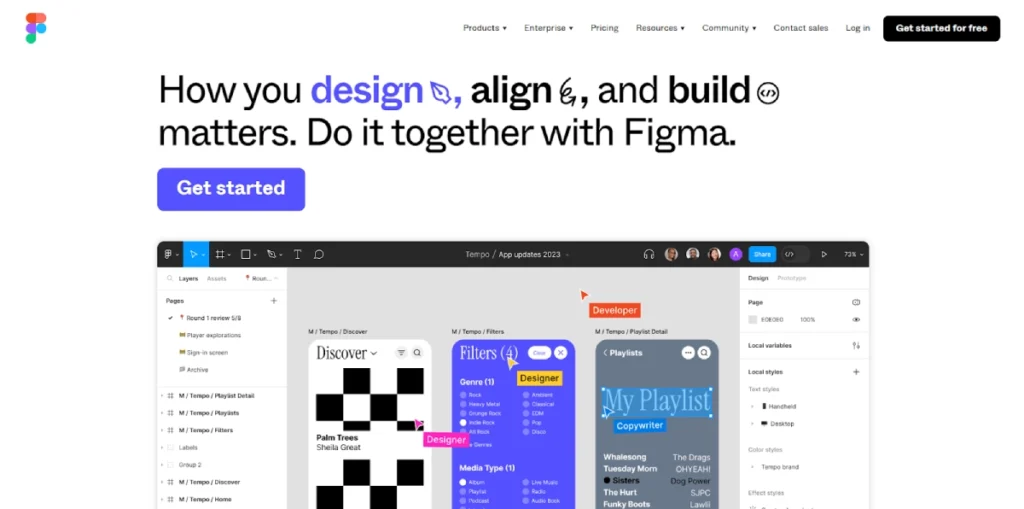
Figma is currently the most popular design tool among UI designers. You can also be assured this is not the last time you will hear about Figma in this article.
After all, Figma set the standards for most UI design tools that came afterward, one of which was the collaborative feature, which they call “multiplayer design”, allowing teams to work simultaneously on one Figma file.
This allows teams to work together and brainstorm during wireframing and mockups making it the ideal tool for this purpose.
Figma allows basic tools for free users with three collaborative design files. For more premium features, you have to pay $12 a month.
Sketch – Best for iOS
Main features: Design, Collaboration, Prototype, Developer Handoff, Plugins
Price: $10 a month
Notable users: Mercedes Benz, Google, Porsche, Toshiba, Ralph Lauren, Facebook
Website link: https://www.sketch.com/
Advantage:
- Clean and easy-to-understand interface
- Have most features expected of a design tool
- Allows intuitive creation of wireframes
Disadvantage:
- Exclusive to Mac and iOS platforms only
- Slow to adopt industry-standard features
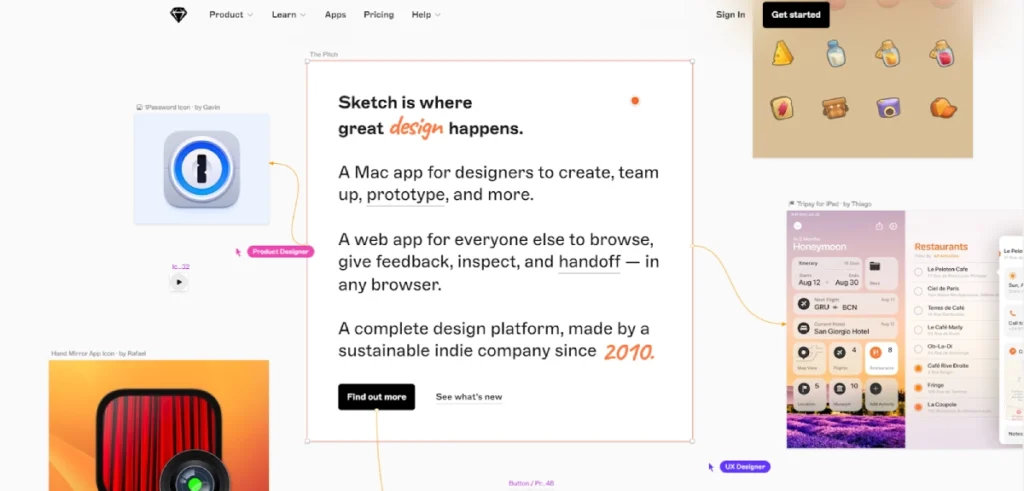
Sketch is considered the second most popular design tool, despite being exclusive to Mac and iOS platforms only.
While it no longer has the dominant market share like before, it is still used widely by a large number of designers. This is especially important if you are creating anything for Mac and ioS platforms. It has all the features you might need (even though it can be quite slow in updating itself to industry standards), making it great for wireframing and mockups.
They offer a free 30-day trial after which you can use Sketch by spending $10 a month.
Axure RP – A Veteran Tool
Main features: Design, Prototype, Integration with other tools
Price: $29 a month
Notable users: Amazon, Salesforce, BBC, Verizon, Microsoft
Website link: https://www.axure.com/
Advantage:
- Can handle complex operations
- Has every necessary feature needed for UI design
Disadvantage:
- Too complex for simple tasks
- High learning curve
Axure RP is a long-running design tool in the industry used by big-name companies such as Amazon, Microsoft, and the BBC. It is a dedicated wireframing tool that also allows prototyping and integrated HTML. It is the tool of choice for more advanced UI designers who have to tackle complex tasks from the get-go.
Axure RP allows a free 30-day trial after which you can pay $29 a month. If you decide to pay the bill annually, the rate will become $25 per month.
Wireframe.cc – The Simplest Wireframing Tool
Main features: Context-based toolbar, Simple UI, easy to use
Price: $12 per month
Notable users:
Website link: https://wireframe.cc/
Advantage:
- Simplest tool for wireframing
- Very easy to set up and integrate into the workflow
- Simple learning curve
Disadvantage:
- Cannot be used for anything other than wireframing
- Will need the collaboration of other tools
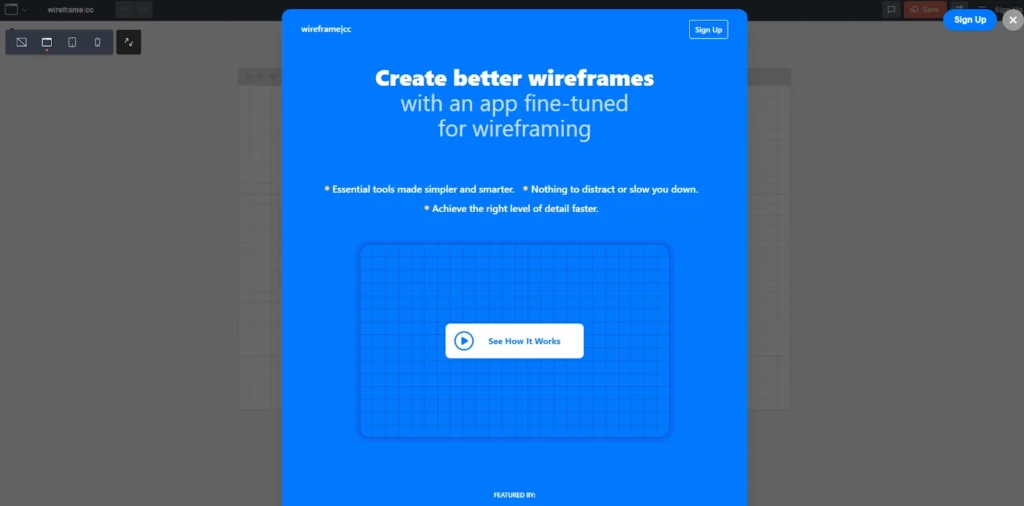
This is quite possibly the simplest design tool you will find in this list. You can just go to Wireframe.cc and start working on your wireframe right away straight from your browser. It has a very simple and clean overlay with a context-sensitive toolbar that only shows the options that are applicable based on the situation. It is the best wireframing tool for any beginner-level designer.
It offers a free 7-day trial when you sign up during which you can use all of the premium features. After that, you can choose to pay $12 per month or pay for the year upfront which will cost at a rate of $9 a month.
Microsoft PowerPoint – The Most Familiar Design Tool
Main features: Presentation, design, animations
Price: $69.99 a year (Part of the Microsoft 365 package)
Notable users: Used universally by most companies for different reasons
Website link: https://www.microsoft.com/en-us/microsoft-365/powerpoint
Advantage:
- Likely already available on your device
- Probable familiarity with the tool
Disadvantage:
- Not specifically designed for UI
- Lack of integration with other design tools
- Not recommended if not already proficient
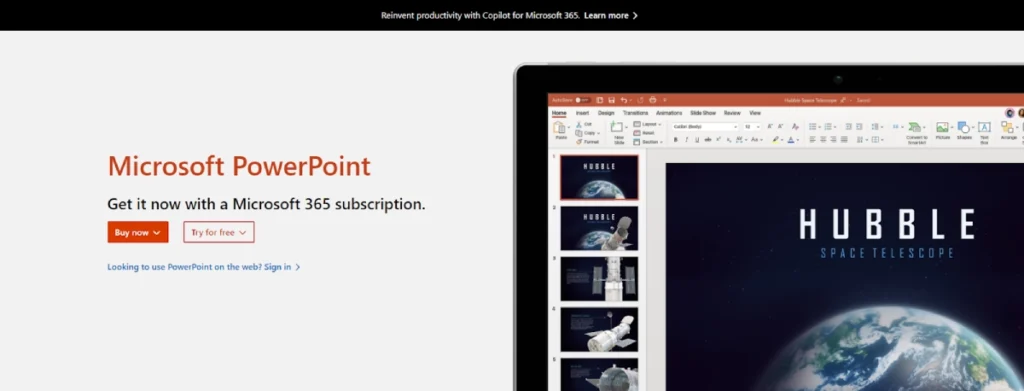
Microsoft PowerPoint is not conventionally used as a design tool, but it can help you get started with creating wireframes and mockups.
It also helps that almost everyone has some sort of experience using it for various study and work-related purposes, making it a familiar tool that will not take much time to get used.
While not recommended for complex professional uses, it can be a great tool to showcase your visions and ideas to experts who can use more complex tools to bring your ideas to life.
If you are using a PC or a laptop with Windows OS, you probably already have it installed. Otherwise, you can purchase Microsoft 365 which includes PowerPoint for $69.99 a year. (We do not recommend you purchase it for this specific purpose if you do not already own it)
Adobe Photoshop – Can be Used for Anything
Main features: Image editing, Designing
Price: $22.99 a month
Notable users: Used universally by most companies for different reasons
Website link: https://www.adobe.com/
Advantage:
- Likely already available on your device
- Probable familiarity with the tool
Disadvantage:
- Not specifically designed for UI
- Not recommended if not already proficient
While not specifically for wireframing, Adobe Photoshop is a universal tool learned by most people in any field that involves design. If you or a member of your team is proficient in Adobe Photoshop, you can use it for wireframing and mockup purposes. With it being feature-rich, a Photoshop expert can design a wireframe or mockup here.
With a 30-day free trial, you can get Adobe PhotoShop with a $22.99 monthly subscription. Just like with Microsoft PowerPoint, we only recommend PhotoShop if you already have it and know how to use it. We do not recommend purchasing it just for wireframing and mockup purposes.
Animation Design
Adding animations to the UI of your product can spice up the visibility or add flare you would not have otherwise. You may find yourself in a situation where you want to add animations but the tool you have been working on is not compatible with them.
If you are eager to add animations to your UI and avoid a situation like that, or even create animations, here are some tools you can use for animation design.
Figma
Main features: Design, Prototyping, Dev mode, Design systems, Team Collaboration
Price: $12 a month
Notable users: Microsoft, The New York Times, Airbnb, Coinbase
Website link: https://www.figma.com/
Advantage:
- Built-in tools for animation
- Can import animated GIFs
Disadvantage:
- Cannot import complex animations made in other tools like After Effects
- Need help of other tools
We told you Figma would be back. Not only for wireframing, but it also has built-in features for creating animations. You can create them here or import animated GIFs into your UI.
Adobe After Effects – The Industry Standard Animation Tool
Main features: 2d Vector animation, Basic 3d animation, UI/UX mock-up animations, Visual effects
Price: $22.99 per month
Notable users: Disney, Time Warner, Espn, University of Maryland
Website link: https://www.adobe.com/products/aftereffects.html
Advantage:
- Can create advanced animation
- Feature-rich toolkit
Disadvantage:
- Not primarily used for UI design
- Lack of seamless compatibility with UI design tools
Adobe After Effects is one of the main tools for creating animations. While not primarily a UI design tool, you can use it to create animations for UI and export them to any compatible design tool.
Axure RP
Main features: Design, Prototype, Integration with other tools
Price: $29 a month
Notable users: Amazon, Salesforce, BBC, Verizon, Microsoft
Website link: https://www.axure.com/
Advantage:
- Can create standard animations
- Industry-standard toolkit with all you may need
Disadvantage:
- Can be difficult to create complex animations
- High learning curve
Axure RP has built-in animation tools that you can easily integrate with your UI mockups and prototypes. As a commonly used tool by designers, it is great if you are looking to integrate simple animations into your projects.
Best for Prototyping & Interaction Design
We have talked about wireframes and mockups, and what tools to use for them. To truly test their effectiveness, you will need to create interactable versions of them which are known as prototypes. Here are some tools for building prototypes of various fidelities.
Figma
Main features: Design, Prototype, Dev mode, Design systems, Team Collaboration
Price: $12 a month
Notable users: Microsoft, The New York Times, Airbnb, Coinbase
Website link: https://www.figma.com/
Advantage:
- Can handle low to high-fidelity prototypes
- Great for both beginners and pros
Disadvantage:
- Will need the help of other tools for more specialized actions
- Can get expensive over time
Figma is also capable of creating low to high-fidelity prototypes for testing. With its intuitive toolset, you can join various elements in the overlay and select what type of interactions they will have for the user. Once you are done, you can test the mobile versions through its app or share it around with a link to test it on a browser.
Proto.io – Prototyping Tool with Asset Library
Main features: Building, Prototyping, Collaboration, Account Management, Support & Documentation, Security
Price: $29 a month
Notable users: Paypal, Ideo, Amazon, Showtime, Nordstrom
Website link: https://proto.io/
Advantage:
- Highly collaborative tool
- Specialized in high-fidelity prototyping
Disadvantage:
- It is 100% web-based, so you cannot work on it without internet
- Primarily a prototyping tool that may lack some features
Proto.io allows you to create low-fidelity prototypes from scratch or even import designs from other tools like Figma, Sketch, or PhotoShop. You can connect these pages in your desired structure and add in digital assets and animations from Proto.io’s library consisting of over 6000 assets. You can view it in preview mode or share it around as an app version.
Sketch
Main features: Design, Collaboration, Prototype, Developer Handoff, Plugins
Price: $10 a month
Notable users: Mercedes Benz, Google, Porsche, Toshiba, Ralph Lauren, Facebook
Website link: https://www.sketch.com/
Advantage:
- Can create low and high-fidelity prototypes
- Can be easily tested on iOS platforms
Disadvantage:
- May need to convert prototypes into other formats to test on other platforms
- iOS platform exclusive tool
Similar to Figma, you can link up various static screens. You can add pressable buttons, fix certain design elements in place, and set start points to fix which artboard will be presented first. You can preview prototypes directly in the Sketch app for Mac, in the Sketch Mirror app for iOS devices, or through a browser.
ProtoPie – Specialized prototyping tool
Main features: High-fidelity prototyping
Price: $79 per month
Notable users: Spotify, BMW, Microsoft, Warner Bros. Discovery, Meta
Website link: https://www.protopie.io/
Advantage:
- Great and simple-to-use prototyping tool
- Integration with most design tools
Disadvantage:
- Can only be used for prototyping
- Cannot build anything from the ground up and will need to import designs from other tools
ProtoPie is a specialized prototyping app, meaning you cannot design any wireframes or mockups here, you will need to import static design from other design tools. Once imported, you can connect these static designs and add how interactions will work. You can add clickable areas, how they will respond, and how the pages will be connected. Once your prototype is created, you can preview it in the preview window, upload it to the cloud, and share it around with a link or a QR code.
The free version allows 2 prototypes to be saved and used on their Cloud service with some limitations, while the premium version unlocks everything for $79 a month. Signing up for a yearly subscription will cost you $67 per month.
Best for User Testing & Feedback
After creating all the necessary designs and prototypes, it is necessary to test them out among users to determine the validity of your interfaces. Here are some resources that can help you collect valuable insights into what sort of changes you should be making for your UI.
Userlytics
Main features: user experience studies, tree testing, usability tests, card sorting
Price: $49 a month
Notable users: Logitech, Riot Games, Verizon, Nespresso, Canon
Website link: https://www.userlytics.com/
Userlytics is one of the best tools to conduct research on any digital products like applications, prototypes, websites, and many others. You can get specific insights that can tell you what you should work on during the UI design process.
Maze
Main features: Integration with popular tools, Real-time reports, Remote testing, IA testing, Collaboration features, Templates, Question repositories
Price: $99 a month
Notable users: National Geographic Society, Walmart, Cisco, McKinsey & Company
Website link: https://maze.co/
We already mentioned Maze is a great platform for collecting user insights and datasets. You can run your prototypes through various situations to collect great insights. We also already mentioned that it seamlessly integrates with popular design tools like Figma, Sketch, and many more. It has an automated report feature making sure your team does not have to waste time collecting data and making a report themselves.
Lyssna – Most features in one
Main features: Remote user testing, first-click testing, design surveys, preference testing, five-second tests, participant recruitment
Price: $79 a month
Notable users: GoDaddy, Unilever, Hello Fresh, Asana, L’OReal
Website link: https://www.lyssna.com/
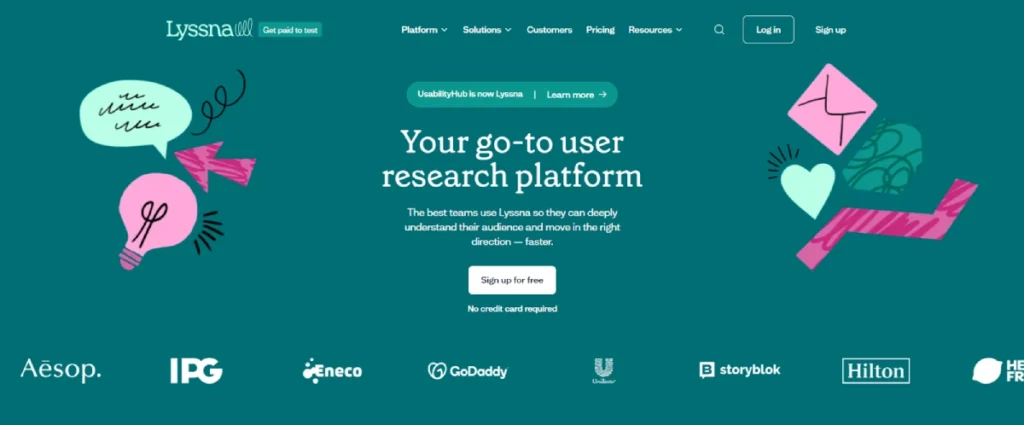
With different types of tests available that can give you all types of data based on your needs, not to mention its accolades, you can rest assured and trust this site for valuable user inputs.
Userzoom – A diverse list of tools & user participants
Main features: Usability testing, interviews, surveys, intercept testing, click testing, tree testing, card sorting, diverse participant recruitment
Price: Available upon request
Notable users: Amazon, Burberry, Costa Coffee, EssilorLuxottica
Website link: https://www.usertesting.com/platform/userzoom
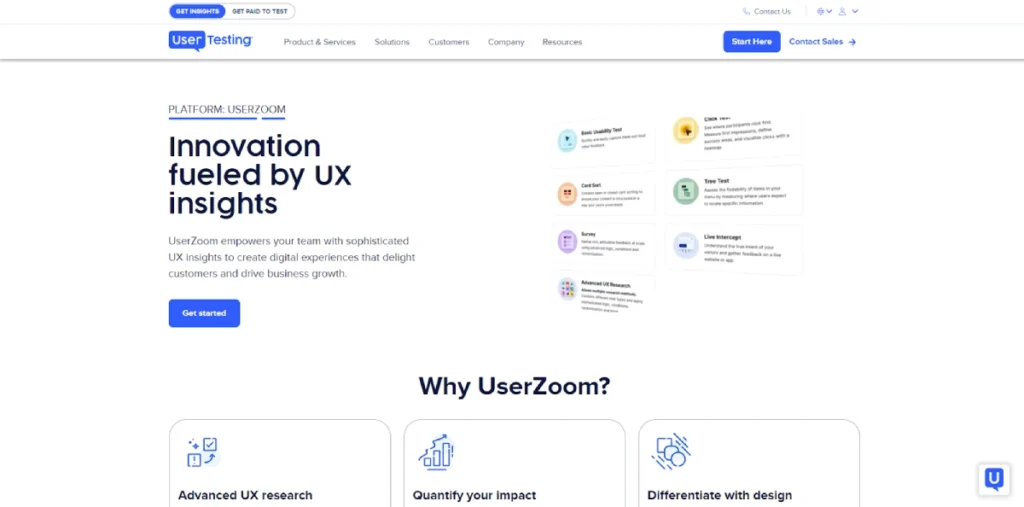
Userzoom is another remote research platform like Lyssna with its own diverse offerings. By using Userzoom, you can run unmoderated task-based studies on a global audience. You can run tests for websites, prototypes, or any sort of mock-up.
Their pricing is available based on what service you are using from them. Some of their key features are usability testing, interviews, surveys, intercept testing, click testing, tree testing, card sorting, and diverse participant recruitment.
Hotjar – Live user behavior observation
Main features: Heatmaps, Recordings, Feedback, Surveys, Interviews
Price: $39 a month
Notable users: Adobe, Hubspot, Hello Fresh, Unbounce
Website link: https://www.hotjar.com/
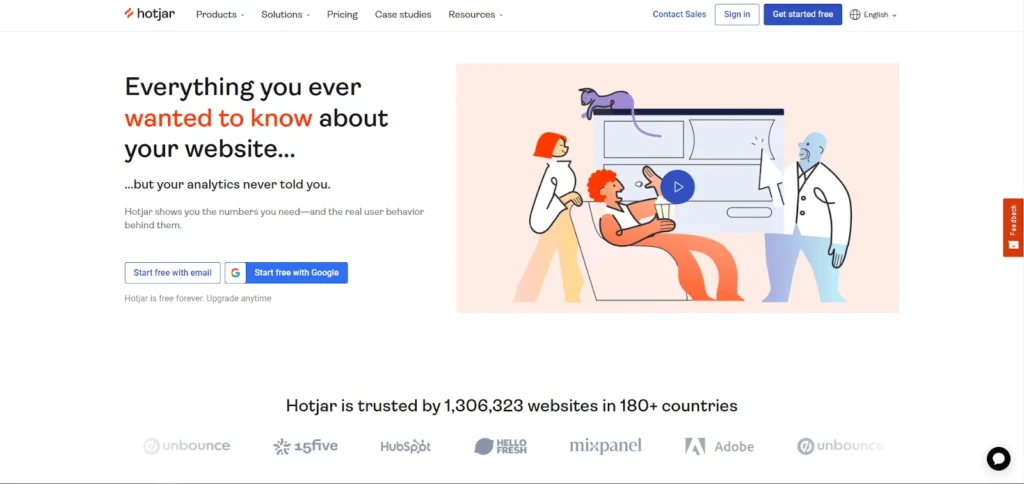
Hotjar lets you observe user behavior via its heat mapping and screen recording tools. They also let you conduct surveys among a diverse audience for general or specific issues.
They allow 35 sessions free from their website. Afterward, their usual pricing starts at $39 a month which gives you 100 sessions.
Best Design Collaboration & Developer Handoff Tools
Chances are that you will be working in a team when creating your solution. Here are some great design tools with collaborative features that can help you work in sync with your team.
Figma
Main features: Design, Prototyping, Dev mode, Design systems, Team Collaboration
Price: $12 a month
Notable users: Microsoft, The New York Times, Airbnb, Coinbase
Website link: https://www.figma.com/
Advantage:
- Great collaboration features
- Dev mode allows for easy handoff of design to developers
Disadvantage:
- Dev mode can feel shallow
- May require getting used to the mode
Figma has standardized this feature for a lot of top design tools, and as one of the first to introduce this feature, it is one of the best through FigJam. And with its Dev mode feature, it gives developers the tools they need to translate designs into code.
Miro – Top Collaboration Tool
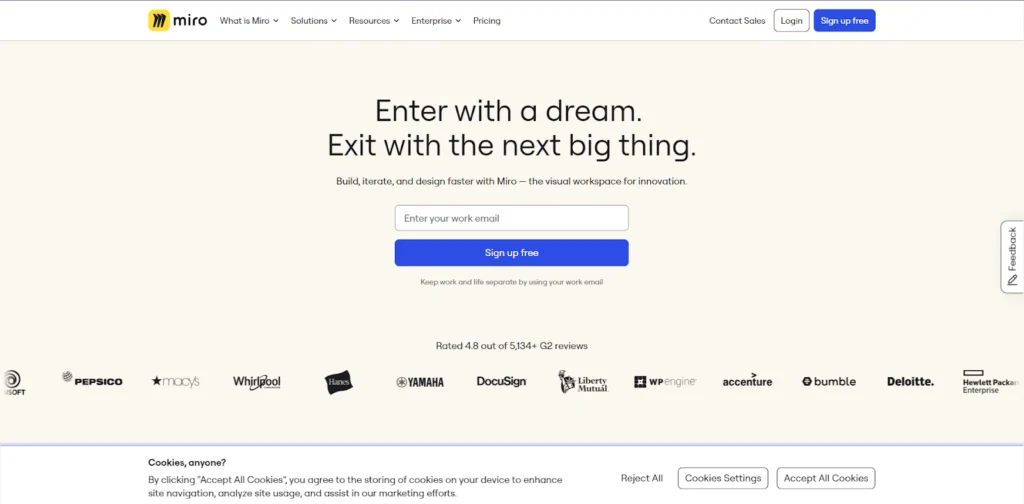
Main features: Product overview, visual project management, apps & integration, diagramming & process mapping, content & data visualization
Price: $10 per month
Notable users: Asos, Deloitte, Pepsico, Dropbox, Macy’s
Website link: https://miro.com/
Advantage:
- Great collaboration tools
- Makes it easy to hand off designs between departments
Disadvantage:
- Not primarily a UI tool which may lack some specific desired features
- This will require setting up every tool
With a clean user interface, you can access all your toolkit whenever you need it, making it easy to integrate with your teammates. The free version has no limits on how many teammates you can have, so your whole team can join in no matter how big your team is. It only limits you by giving you 3 editing boards. Their monthly plan starts at $10 but getting their annual plan will have you paying at a rate of $8 a month.
Zeplin- Best handoff tool
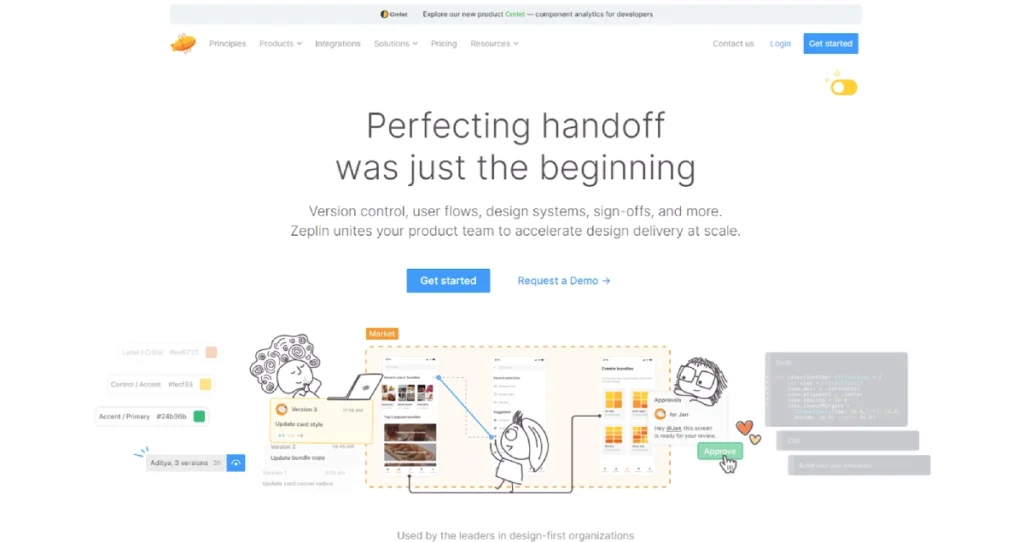
Main features: Document designs, Build scaling, Design system analytics, integration with other tools, Collaborative Features
Price: $8 a month
Notable users: HSBC, Salesforce, Amazon, Autodesk, Talk
Website link: https://zeplin.io/
Advantage:
- Helps with the documentation process
- Compatible with most industry standard tools
- Makes it easy to hand off designs between departments
Disadvantage:
- Not primarily a UI tool which may lack some specific desired features
- This will require setting up every tool
Zeplin is a collaboration hub tool that allows for great synergy within the team, whether in the office space or working remotely. It also allows for seamless transfer of files in whatever format they are necessary.
Zeplin allows a team of 6 people to work on 1 project within 30 days as a trial. After that, their rates start at $8 a month.
Coding for UI Implementation
While you can get away with not learning coding and programming languages for UI design, it is highly suggested you learn HTML, CSS, or JavaScript to hone your design skills.
Even if you get a small understanding of it, it will help you collaborate with your team more effectively. And if you become proficient with them, you can even create high-fidelity prototypes on your own.
Keep in mind though that just as an architect does not need to construct their design, you do not NEED to code anything, just having a good understanding of it will help you a lot. It will help you create feasible designs for your developers.
How to Pick the Best UI Design Tools?
As you can see, you will be reliant on different tools and resources for different stages of the creation process. No one tool can cover all of your activities, especially if you are working on a complex project. A lot of factors will come into play in deciding which tools are best for you.
Here are a few questions you should be asking yourself when deciding your tools of choice.
- How easy is it for my team to use?
- How different is it from the tools my team is used to working with?
- Are the features available in the tool enough for our project?
- Is it compatible with all the different teams we will be collaborating with?
- How much money will it cost and how will it affect our overall budget?
- Are the different tools integrated with each other?
Consider every situation and angle to make a decision and make sure to consult with your team about it. Having the right tools will optimize your workflow. Remember feature-rich tool does not automatically qualify it for being the best. Too many features can complicate the process and confuse you. Make sure your tool has the right amount of what you need during selection.
Final Thoughts
We hope now you have a solid understanding of all the best UI design tools out there. We arranged the article in a way so that you know which tools are best for which cases and you can select the right tool based on what you want to focus on.
If you are still not sure where to start, contact us for more specific questions. Our team of experts can help you understand the intricacies of UI design and can even help you throughout your journey.


